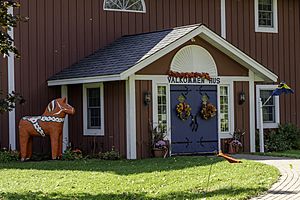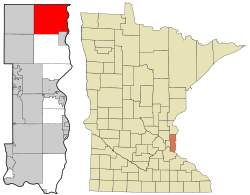Scandia, Minnesota facts for kids
Quick facts for kids
Scandia
|
|
|---|---|

Gammelgården Museum with Dala horse
|
|
| Motto(s):
"Dedicated To Rural Community Values"
|
|

Location of the city of Scandia
within Washington County, Minnesota |
|
| Country | United States |
| State | Minnesota |
| County | Washington |
| Area | |
| • Total | 39.85 sq mi (103.22 km2) |
| • Land | 34.85 sq mi (90.27 km2) |
| • Water | 5.00 sq mi (12.95 km2) |
| Elevation | 1,040 ft (320 m) |
| Population
(2020)
|
|
| • Total | 3,984 |
| • Estimate
(2021)
|
3,963 |
| • Density | 114.31/sq mi (44.14/km2) |
| Time zone | UTC-6 (CST) |
| • Summer (DST) | UTC-5 (CDT) |
| ZIP code |
55073
|
| Area code(s) | 651 |
| FIPS code | 27-58900 |
| GNIS feature ID | 2396548 |
Scandia is a city in Washington County, Minnesota, in the United States. In 2020, about 3,984 people lived there. Scandia is located about 25 miles northeast of Saint Paul, Minnesota.
Contents
History of Scandia
Scandia has a strong connection to its Scandinavian roots. It is thought to be the first place in Minnesota where Swedish immigrants settled. In 1850, the very first log cabin was built near Hay Lake. Later, in 1856, the first Elim Lutheran Church was built close to the lake.
For many years, Scandia was known as New Scandia Township. It officially became a city on January 1, 2007. This change happened to make sure the community would not be taken over by the nearby city of Forest Lake. The city has its own weekly newspaper called the Country Messenger.
Fun Places to Visit
Scandia offers several interesting places to explore its history and culture.
Gammelgården Museum
The Gammelgården of Scandia has worked since 1972 to save and share Swedish immigrant history. They host fun events like Spelmansstämma, Midsommarafton, and Dalapalooza. Dalapalooza is named after the large Dalecarlian horse statues that welcome visitors to the city.
Hay Lake School
The Hay Lake School was built in 1896. This school was part of rural school district #2, which started in 1855. Before this brick building, students met in local homes. Later, they used the old Elim Lutheran Church building, which is now part of the Gammelgården complex. The Hay Lake School was added to the National Register of Historic Places on July 1, 1970.
Erickson Log House Museum
The Erickson Log House Museum features a log house built in 1868. Johannes Erickson and his 13-year-old son, Alfred, built it. In 1904, Alfred built a new house. The old log house then became a granary, a garage, and even a playhouse. In 1974, the Washington County Historical Society bought the log house. They moved it about one and a half miles to where it stands today. The Erickson Log House was added to the National Register of Historic Places on June 17, 1976.
Washington County Barn Quilt Trail
The Washington County Barn Quilt Trail is a scenic route that is about 16.4 miles long. It goes through Scandia, Marine on St. Croix, and the Town of May. Along this trail, you can see 18 barn quilts. These large painted quilt patterns are based on designs from the book The Quiltmaker's Gift.
Scandia's Location
Scandia covers an area of about 39.82 square miles (103.22 square kilometers). Most of this area is land, with about 5.02 square miles (12.95 square kilometers) being water. The city is located halfway between Stillwater and Taylors Falls. Both of these towns are along the St. Croix River. Scandia is also close to William O'Brien State Park. Two main roads that go through Scandia are Highway 95 and Highway 97.
People of Scandia
| Historical population | |||
|---|---|---|---|
| Census | Pop. | %± | |
| 2000 | 3,692 | — | |
| 2010 | 3,936 | 6.6% | |
| 2020 | 3,984 | 1.2% | |
| 2021 (est.) | 3,963 | 0.7% | |
| U.S. Decennial Census 2020 Census |
|||
In 2010, there were 3,936 people living in Scandia. There were 1,499 households and 1,178 families. The city had about 113 people per square mile. Most of the people living in Scandia (97.2%) were White. About 1.3% of the population was Hispanic or Latino.
About 30.1% of the households had children under 18 years old. Most households (69.9%) were married couples. The average household had 2.61 people, and the average family had 2.94 people. The median age in Scandia was 46.9 years old. About 22.7% of the residents were under 18.
See also
 In Spanish: Scandia (Minnesota) para niños
In Spanish: Scandia (Minnesota) para niños

